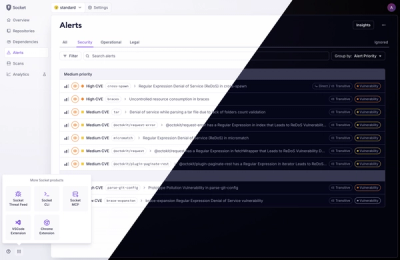
Product
A Fresh Look for the Socket Dashboard
We’ve redesigned the Socket dashboard with simpler navigation, less visual clutter, and a cleaner UI that highlights what really matters.
vue-auth-jwt
Advanced tools

Vue Auth JWT is a lightweight Vue plugin for communicating your Vue application with a JWT (JSON Web Token) powered authentication backend.
It provides simple simple Vuex-based methods that apply the correct credentials and request styles to easily add the JWT access tokens in the request headers, and refresh them when appropriate.
Also included is an instance of the Axios package, so there is no need to install this separately.
Vue Auth JWT does not make use of localStorage, which is vunerable to cross-site scripting (XSS) attacks.
Instead, it assumes that the application's backend uses httpOnly cookies, which javascript has
no access to.
For this reason, to make the library work, your backend must set the tokens directly. For example,
if you're a Python user, the Django library dj-rest-auth has a setting for JWT which sends the cookies in
just the right way. Whatever backend you use, be sure the tokens are sent directly as httpOnly cookies,
and be sure CORS is set up correctly.
You will also need:
– A working Vue.js application (including Vue frameworks, like Nuxt or Quasar)
– A working JWT backend, such as Django Simple JWT
– A Vuex store installed
– A Vue router instance
To install Vue Auth JWT, first add it to your project
npm install vue-auth-jwt
or
yarn add vue-auth-jwt
Then instantiate the plugin by adding:
const config = {
API_BASE_URL: 'https://api.example.com:8000/',
}
Vue.use(Auth, { router, store, config });
The location of this code will vary depending on your set up, but it must have access to the Vue Router and Vue Store instances.
The only mandatory endpoint to add to the configuration is API_BASE_URL,
but it is likely that others will also be necessary to serve even basic JWT backends.
The full list of configuation options can be found in the Configuration Options
section below.
same-site concernsAlthough vue-auth-jwt has been written with decoupling between frontend and backend in mind,
it may be necessary to host both frontend and backend at the same domain. However, subdomains
are fine, so if you run your site at example.com, you can still host your backend at api.example.com.
While using these subdomain names will be trivial in production, setting up a development environment with domain names and SSL is less obvious.
You can set the localhost IP address (usually 127.0.0.1)
to a custom domain in your hosts file (this will be /etc/hosts in Unix), and then run your dev environment at
something like
https://api.example.com:8000
Note the https here. It may also be necessary to use SSL/TLS (even in your development environment)
and run your backend within the remit of the same-site attribute. There exist libraries
(like django-sslserver in Python) that will allow you to run with a self-signed SSL certificate for development.
If you'd like to read more about the same-site attribute, please follow this link.
If an authenticated route is requested, vue-auth-jwt will attempt to
validate the user's cookies, and will redirect the user to a
login screen if they cannot be verified.
As you choose which routes should be protected by the
authorization, simply add meta: { requiresAuth: true }
to each route.
For more information on the meta attribute, have a look at
this.
default '/login/'
HTTP verb POST
This sets the name of your backend's API endpoint for logging in.
default '/logout/'
HTTP verb POST
This sets the name of your backend's API endpoint for logging out.
default '/token/refresh'
HTTP verb POST
For refreshing the JWT access token. This will usually be done automatically
by vue-auth-jwt when appropriate.
default '/user/'
HTTP verb GET
Endpoint for obtaing details about the logged in user. Should return an object containing user details (e.g. first_name, username, email, etc.).
default '/login'
HTTP verb None
Rather than being an endpoint on the external API, the loginRoute configuration option
is for the login page i.e. it is one of the internal Vue router paths. If
a user is not authorized to visit a page, this is the page they will
instead be directed to. This page can be anything, but is mostly typically
composed of a login form component.
When initialized, vue-auth-jwt provides access to its methods from anywhere in the Vue app
through the use of the global $auth attribute. $auth has access to the methods detailed
below.
The following methods belong to the $auth attribute
set in the installation step.
axios()An instance of the Axios package, configured to handle
the JWT credentials automatically. The baseURL configuration
is already set to the given API_BASE_URL value.
You can use this function just as you would any normal axios request.
Sample Usage
asycn getUserDetails() {
return await this.$auth.axios({ url: '/user/', method: 'GET' });
}
checkTokens()Verifies that the JWT access tokens are still valid, and attempts to refresh them if they are not.
login()Should be attached to the submit button of the login form. Returns a boolean indicating the success or failure of the request.
Sample Usage
async onSubmitLogin() {
const loginOk = await this.$auth.login({
username: 'bojangles',
password: 'secret123'
})
}
logout()Logs out the user.
Sample Usage
async onSubmitLogout() {
await this.$auth.logout()
}
user()Returns details about the logged in user. If backend is
set to false (default), the method will simply return the
user details currently set in the Vuex state. To query the
backend for the up-to-date user info, set backend=true.
Sample Usage
async getUserDetails() {
const user = await this.$auth.user(backend=false)
}
vue-auth-jwt is a very young open source tool, and I would be very
happy to welcome contributors. If you would like
to contribute, send me an email at johnckealy.dev@gmail.com.
FAQs
*An open-source Vue.js authentication package for JWT*
The npm package vue-auth-jwt receives a total of 5 weekly downloads. As such, vue-auth-jwt popularity was classified as not popular.
We found that vue-auth-jwt demonstrated a not healthy version release cadence and project activity because the last version was released a year ago. It has 1 open source maintainer collaborating on the project.
Did you know?

Socket for GitHub automatically highlights issues in each pull request and monitors the health of all your open source dependencies. Discover the contents of your packages and block harmful activity before you install or update your dependencies.

Product
We’ve redesigned the Socket dashboard with simpler navigation, less visual clutter, and a cleaner UI that highlights what really matters.

Industry Insights
Terry O’Daniel, Head of Security at Amplitude, shares insights on building high-impact security teams, aligning with engineering, and why AI gives defenders a fighting chance.

Security News
MCP spec updated with structured tool output, stronger OAuth 2.1 security, resource indicators, and protocol cleanups for safer, more reliable AI workflows.